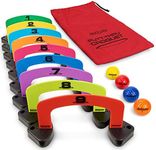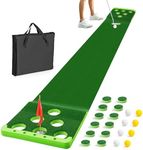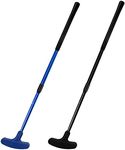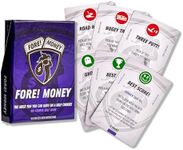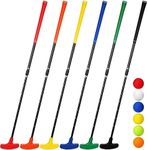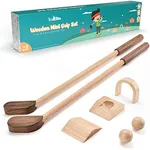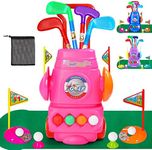Buying Guide for the Best Golf Putting Sets
Choosing the right golf putting set can significantly improve your putting skills and overall game. When selecting a putting set, it's important to consider various factors that will best suit your practice needs and personal preferences. Here are some key specifications to look out for and how to navigate them to find the best fit for you.Mat LengthThe length of the putting mat is crucial as it determines the distance you can practice your putts. Shorter mats, typically around 6-8 feet, are great for practicing short putts and are ideal for limited spaces. Medium-length mats, around 9-12 feet, offer a balance between short and long putts, providing a more versatile practice experience. Longer mats, over 12 feet, are suitable for practicing longer putts and are best if you have ample space. Choose a mat length based on the space available and the type of putts you want to practice.
Mat SurfaceThe surface of the putting mat affects the roll and speed of the ball, simulating different types of greens. A smooth surface mimics fast greens, while a textured surface simulates slower greens. Some mats offer adjustable speeds by allowing you to change the surface texture. If you play on a variety of greens, a mat with adjustable speeds can be beneficial. Otherwise, choose a surface that closely matches the type of greens you most frequently play on.
Alignment GuidesAlignment guides are markings on the mat that help you line up your putts correctly. These guides can be simple lines or more complex patterns that assist with both alignment and distance control. For beginners, alignment guides are very helpful in developing a consistent putting stroke. More experienced golfers might prefer fewer guides to better simulate real putting conditions. Consider your skill level and how much assistance you need with alignment when choosing a mat with or without guides.
PortabilityPortability refers to how easy it is to transport and store the putting set. Some mats are designed to be rolled up and stored away easily, making them ideal for those with limited space or who want to practice in different locations. Others are more permanent setups that require a dedicated space. If you need to move your putting set frequently or have limited storage space, look for a portable option. If you have a dedicated practice area, a more permanent setup might be suitable.
Ball Return SystemA ball return system automatically returns the ball to you after each putt, saving you time and effort. Some putting sets come with a built-in ball return system, while others do not. If you prefer continuous practice without having to retrieve the ball after each putt, a set with a ball return system is ideal. However, if you don't mind retrieving the ball yourself, you can opt for a simpler mat without this feature.
Hole Size and PlacementThe size and placement of the hole on the putting mat can vary. Some mats have standard-sized holes, while others have smaller holes to increase difficulty. Additionally, some mats offer multiple hole placements to practice different angles and distances. If you're a beginner, a standard-sized hole will help build confidence. For more advanced practice, smaller holes and varied placements can challenge your skills and improve accuracy. Choose based on your current skill level and the type of practice you want.

